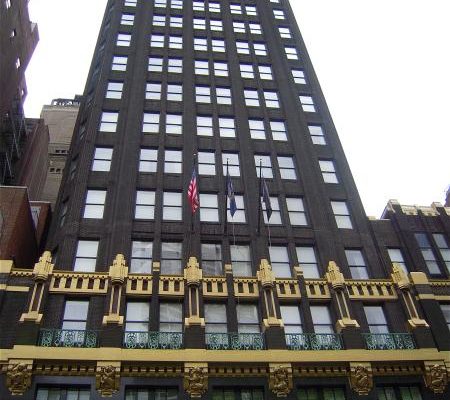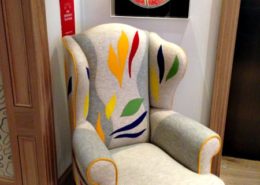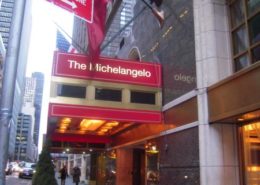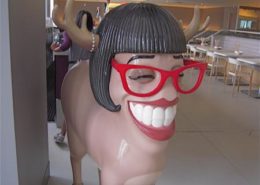Bryant Park Hotel
By Terry Trucco
At a glance: When the Bryant Park hotel opened in 2001, Conde Nast was housed in a nearby skyscraper and Fashion Week unfurled in tents across the street in Bryant Park twice a year. With the Garment District nearby the area was Fashion Central, and the hotel fit right in.
The Bryant Park is still stubbornly chic, even if the New York’s fashion world migrated away years ago. The runway-handsome porters manning the heavy brass and glass doors wear black. Check-in occurs at a lipstick-red lacquer counter parked in front of a matching leather wall. And though the lobby’s dark, wood-paneled sitting area is no bigger than, well, a lipstick, the two armless leather loveseats are undeniably stylish (dressed in the house red, naturally).
The decor also largely unchanged in the lobby and the rooms from the time the hotel opened, a testament to the timeless quality of good bones and clever minimalism. Still, it would be fun to see how the hotel tweaks its decor into the 2020s. If that happens, we hope they’ll create more places to sit in the lobby, the better watch a parade of stylish guests or drink in the view of the park. Better still, how about a sitting room to replace the top floor meeting space? (The spectacular views are by invitation only.)
That said, Koi, the sleek, snooty outpost of the LA Asian-fusion restaurant adjoining the hotel offers cool, timeless glamour. And the Celon Lounge, a Middle-Eastern inspired nighttime haunt with a gorgeous ceiling reminiscent of Grand Central Station’s Oyster Bar, is an artful backdrop for a potent but pricey drink.
And the exterior is delectable: The hotel occupies the American Standard Building, a magnificent black brick Gothic skyscraper as tall and sleek as a supermodel – and immortalized by Georgia O’Keeffe in her 1927 painting “The Radiator Building at Night.”
Rooms: They’re chic, minimal, surprisingly large — and starting to look a bit dated. The standard room we saw, plenty big for two people, was a stark, spotless white envelope with a black metal-frame queen-size bed garbed in white sheets and perched on legs, so you could see beneath. The aubergine leather headboard matched the leather bolster running the width of the bed. We liked the upholstered chair/bench and little table in front of the window, overlooking a cityscape and shielded by white floor-to-ceiling curtains. Besides a closet big enough to hold the fruits of a Manhattan shopping spree, a second closet contained the minibar and “romance accessories,” as the assorted condoms and whatnot were described to us, and an LG flat-panel TV hung on the wall.
The large stone and white bathroom sported a glassed-in stall shower (tub/shower combos are also available), a contemporary rectangular pedestal sink that would look comfortable in a Japanese aparto and Molton Brown toiletries.
Food and drink: Koi, a stylish, pricey Japanese restaurant feels Downtown and serves lunch and dinner in a cavernous, glamorous lair punctuated by dark wood walls and a sleek openwork white ceramic ceiling. There’s almost no upholstery, and the room shrieks (on out first visit, a friend insisted we leave before being seated because she couldn’t stand the din). We returned another day without her — the noise, slightly tuned down, didn’t bother the heartier friend we recruited — and tucked into a lunch of tofu with vegetables in a ginger sauce (delicious) and iced tea (weak). Unlike the hotel, where the staff seems eager to please, service in the restaurant was cool and indifferent.
In fall 2017, the Célon Cocktail Bar & Lounge, a spacious Moroccan-inflected lair, opened in the spot previous occupied by The Cellar. Open at night for craft cocktails that include a $100 martini and Mediterranean bar snacks, Célon has an exotic vibe and a gorgeous tile ceiling reminiscent of the Oyster Bar and can get crowded.
Amenities: The fitness center is clean and well equipped with cardio machines and free weights. Screening room in the basement (alas, it’s only open for private screenings).
Surroundings: A superb Midtown location, equidistant between Times Square and the Theater District, and Grand Central Terminal. The New York Public Library and Bryant Park (ice skating in the winter, outdoor movies in the summer, a merry-go-round year round) are across the street. Fifth Avenue shops, the Museum of Modern Art, Rockefeller Center, the Empire State Building, the Morgan Library & Museum and several multiplex movie theaters are a walk – or cab or Uber ride — away. Bus stops and subway stations are even closer.
Back story: The Bryant Park Hotel building started life in 1924 as the offices of the American Radiator and Standard Sanitary Company, a heating manufacturer. For their new tower holding offices and a showroom, the company looked inward and tapped Raymond Hood, a radiator cover designer. Though inexperienced as a building architect, he understood the company and his assignment. To impart heft and solidity to the narrow, 21-story building he chose black bricks, which also symbolized coal, and trimmed them with gold, embodying fire. Carved allegories depicting the transformation of matter into energy punctuate the exterior (the building housed a heating company, after all). Additionally, the Gothic structure features a cutting-edge set-back design, with parts of the building recessed to make this relatively small structure appear taller. Hood went on to design the Chicago Tribune Building and the massive GE Tower in Rockefeller Center.
The radiator company eventually became American Standard, reflected in the building’s name change. On the National Register of Historic Places site 1980, the was sold to the hotel’s developers in 1998. With a renovation designed by British architect David Chipperfield, the Bryant Park Hotel opened in 2001.
Keep in mind: For a high-end hotel, there’s not much public space that isn’t a restaurant or bar.
































